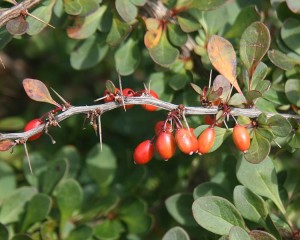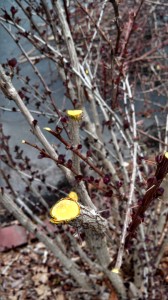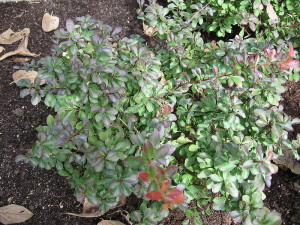
Japanese Barberry (Berberis thunbergii) is an invasive shrub in eastern United States. It can grow in dense forest shade and is not typically eaten by dear. It is commonly used as a landscape plant and a few varieties have been developed for that purpose. Efforts are under way to prevent the species and all its cultivated varieties from being sold in commercial plant nurseries. There is a native Barberry (Berberis Canadensis) but in most places it is not seen as commonly as Japanese Barberry.
Edibility and Culinary Use
The berries and leaves are edible. The taste of the berries is interesting. It has a bitter taste but it also has a hint of sweetness and tartness. It’s slightly too bitter to be something you would want to eat handfuls of.

What I like about this plant is that the fruit holds on to the stem for months, so even in the winter in north eastern and central US you can find berries still hanging on to the plant, and they get sweeter with age so you might find one that’s not to bad tasting. The berries are more commonly used with other fruits in pies, jelly preserves, and drink mixtures. The leaves can also be eaten cooked, but it’s deciduous so they fall off before winter.
Health Benefits
Japanese Barberry and our Native barberry have vitamin C in the fruits. They were both important foods for indigenous people in their native habitats. Like so many other wild edibles the chemical berberine in the plant shows signs of having anti-tumor properties.
Key ID Features
SHARP THORNS! The thorns are small, sharp and plentiful. The interior of the twigs is a yellowish color.
Conclusion

Japanese barberry is an important winter foraging fruit when many fruits are nowhere to be found. You can get vitamin C and a slightly fruity flavor in the middle of winter. Even though the taste of the plant isn’t on the same level as Raspberries and Service Berries it’s persistence into winter is one good reason to look for this plant next time you’re hiking or foraging in cold weather.
Read our Article on: Safe Foraging
Many of our readers find that subscribing to Eat The Planet is the best way to make sure they don't miss any of our valuable information about wild edibles.
See our privacy policy for more information about ads on this site








One Response
Want more info on edible shrubs